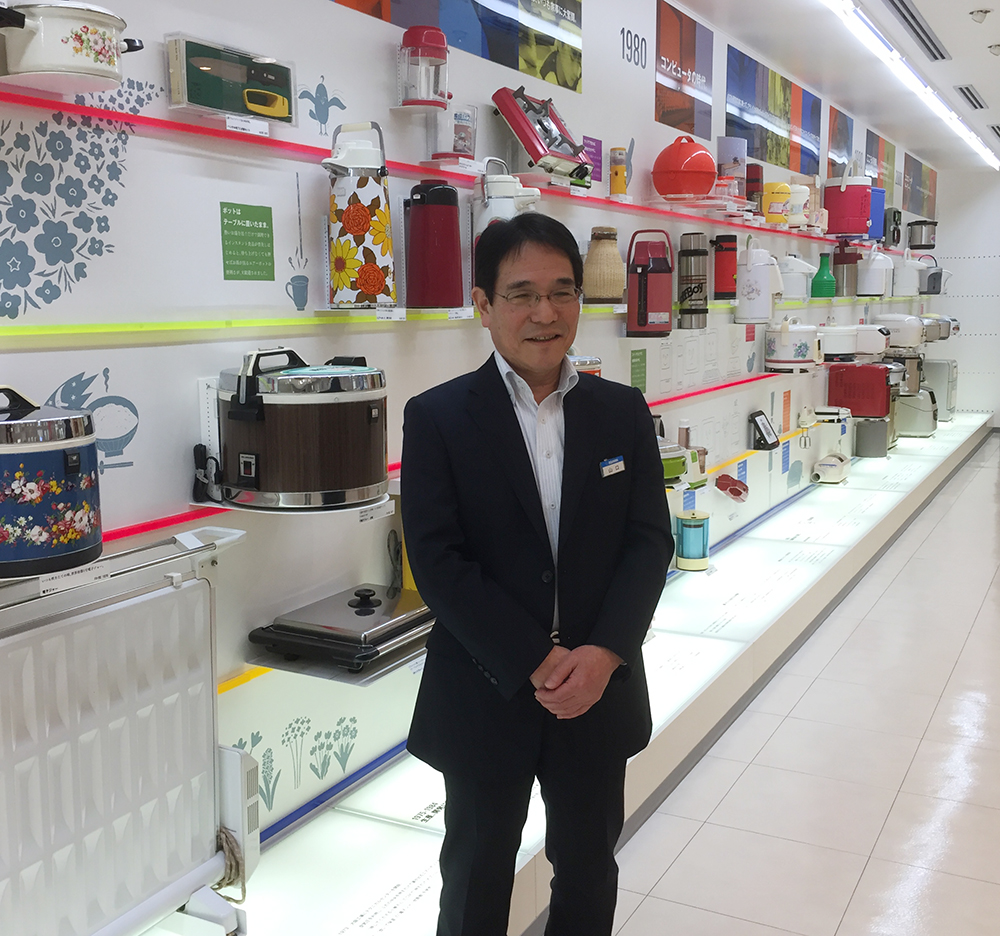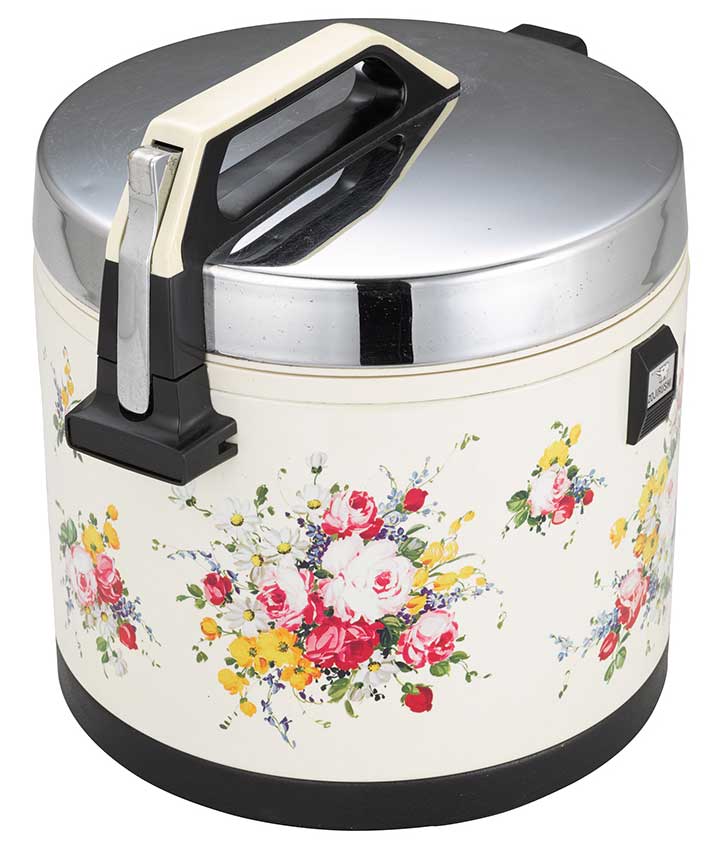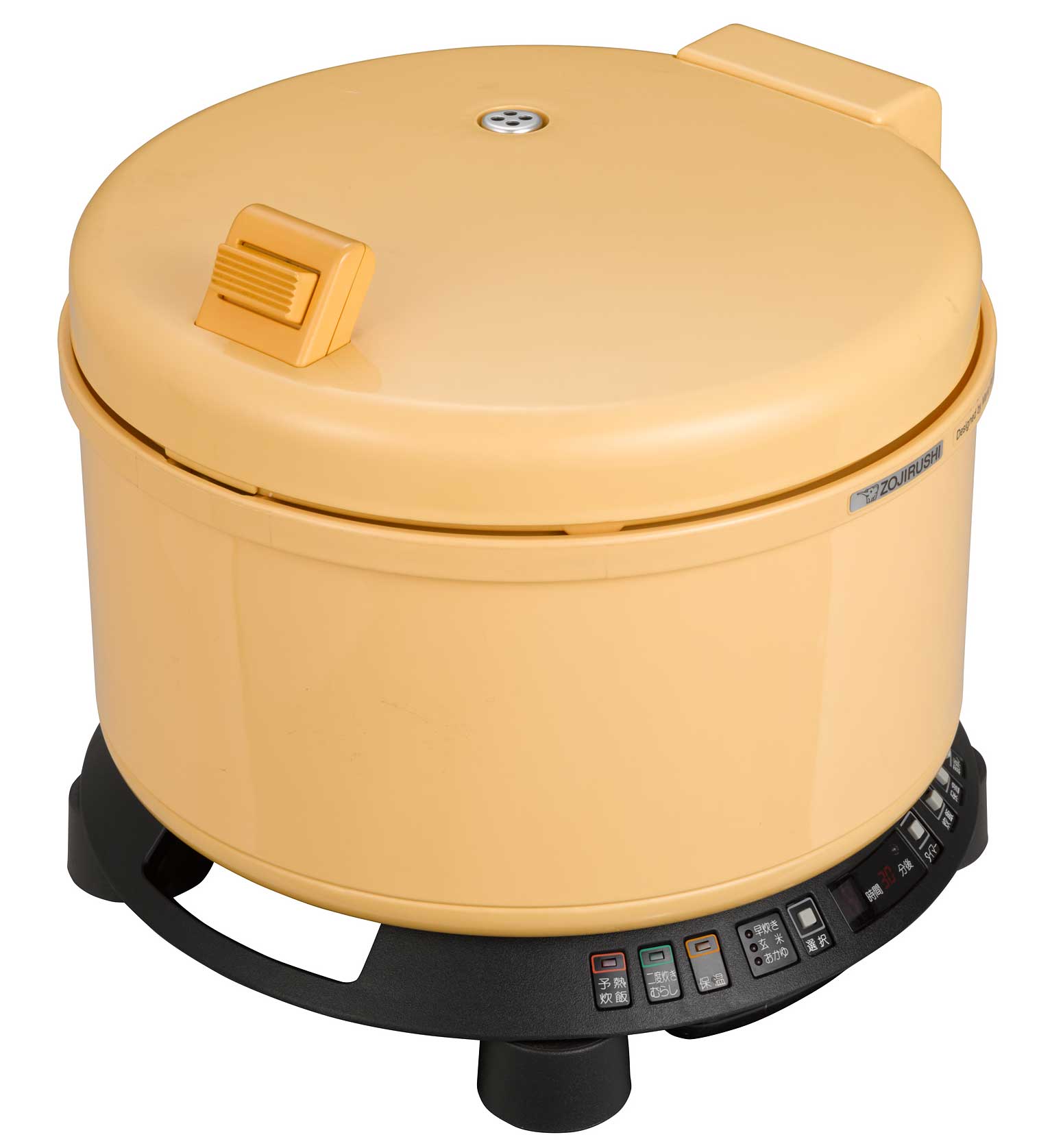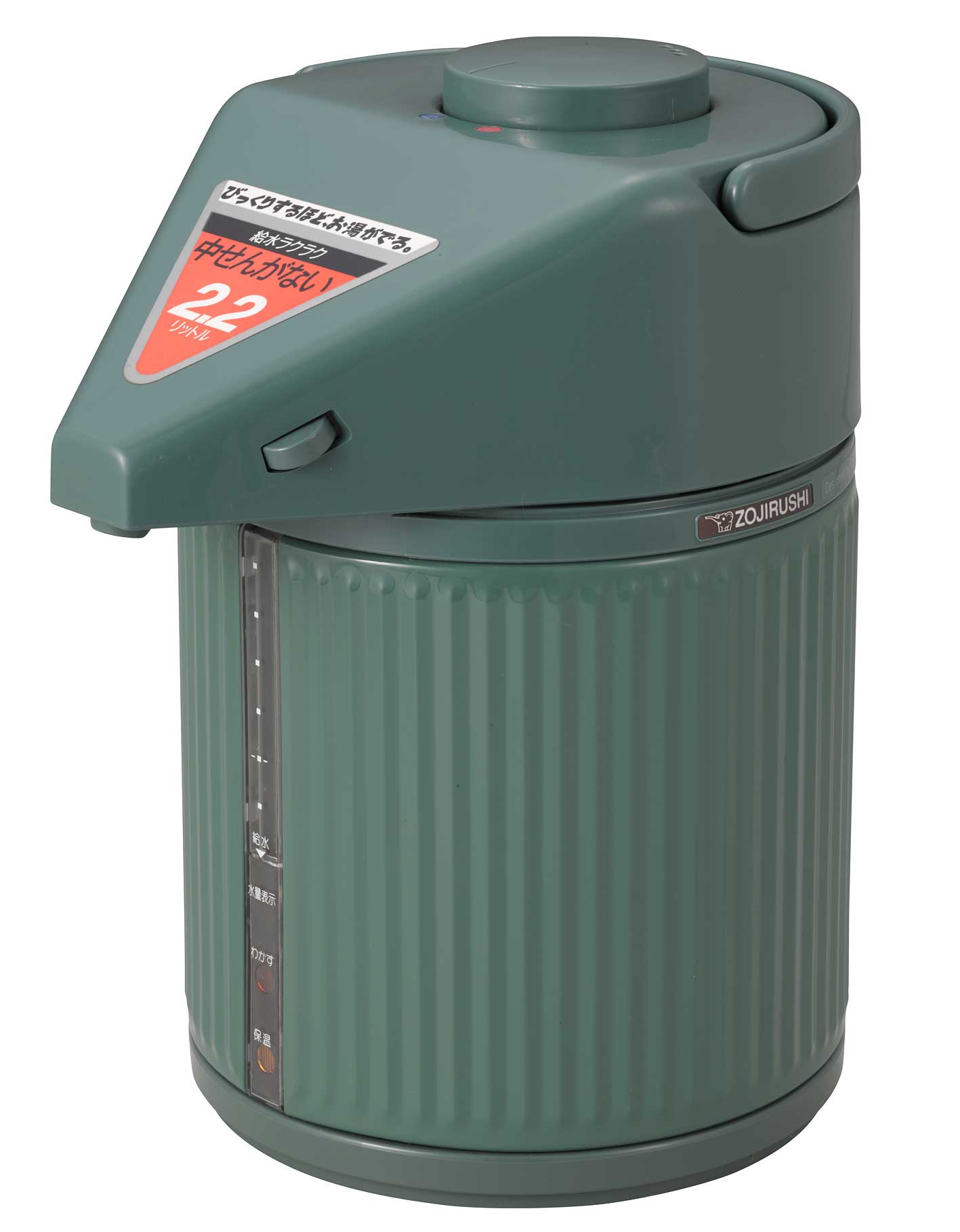
Industrial Design Archives Project
Industrial Design Archives Project

The people behind the design 01
From selling to product planning to communicating
Yamaguchi Mineo
In 2018, Zojirushi Corporation, headquartered in Tenma, Osaka, celebrated its hundredth anniversary. The company shares its centennial with Osaka City Central Public Hall, designated as an important cultural property, and Panasonic, another Osaka-based company. For a home appliance maker whose name and products are known throughout Japan, Zojirushi’s head office is surprisingly modest. If it weren’t for the Mahobin Museum on the ground floor facing Tanimachi-suji, you might easily walk right past the building without noticing it.
However, its staid appearance is perhaps indicative of the company’s origins as one of Japan’s leading glass manufacturers in the city that was the center of the country’s glass manufacturing industry from the Meiji period through the Taisho and Showa periods. That history will likely be new to many people of the present age who tend to associate the name Zojirushi with stainless steel water boilers & warmers. Yamaguchi Mineo joined Zojirushi in 1975 after the oil crisis, and worked in sales, product development, and legal affairs before becoming director of the Mahobin Museum and devoting himself to rediscovering the history of the vacuum flask industry, including the contributions of other companies as well his own. We asked him here to talk a little about himself and his work.
Joining Zojirushi
When I was a student in Matsuyama, Ehime Prefecture, I was drawn to the growing chainstore sector, so I went to my college’s careers support office for advice. They told me that vacuum flasks were taking off in a big way, so I said, "Then maybe I’ll apply to Tiger." It makes me laugh to think about it now. [Tiger was Zojirushi’s biggest rival.] The fact is, I didn’t know any other vacuum flask maker. However, at that time, jobs were in short supply after the oil crisis, so when I was told by a senior that Zojirushi would definitely have at least one opening for a graduate from our college, I decided to go for it. And what do you know, they picked me! I was one of just twenty-five recruits that year, including junior high school graduates assigned to factory posts.
Starting out as a sales rep
I knew from the start that I was being hired for sales, and that was where I was assigned on joining the company. The first two years is a kind of apprenticeship in which you were assigned to after-sales service and demonstration sales. This was before we had anything like a customer helpdesk, and each sales section was assigned a different district, with sales reps visiting households one by one on after-sales service calls. We learned how to do repairs, and when we got a call, we’d visit the customer’s home and repair the product on the spot when we could, or bring it back if we couldn’t. The demonstration sales started the year before I joined the company when it began to roll out products other than rice cookers, such as electric griddles and coffee makers. As the term indicates, I would set up outside a shop and try to catch the eye of passing housewives and show them whatever the product could do. "Come take a look, ma’am, you’ll love it!", that kind of thing. The company had a large kitchen, and we were given instruction there. Home appliance chains like Wako Denki, Joshin Denki, Midori Denka, and Matsuya Denki were going great guns in Osaka at that time, and we’d be sent out to do demonstration sales at their outlets as well as at department stores and specialty stores.
What is a specialty store?
It means hardware store. At that time, vacuum flasks were our flagship product, and supermarkets in those days were different from what they are today, so we were selling our products to hardware stores through dealers. At that time, we had contracts with loads of hardware stores. This was before consumer electronics retailers became a big thing, and hardware stores were our main sales channel. We were even selling electric griddles at hardware stores. But selling electrical appliances among pots, pans, and kettles was tough. Electric griddles cost nearly 10,000 yen, which was twice the price of a tabletop water boiler. Very few people went to hardware stores to splash 10,000 yen on something. There were many days I’d spend the whole day doing demonstration sales at one of my assigned hardware stores, and not sell a single product. It could be pretty dispiriting, especially when workmates handling department stores would come back with ten or even twenty sales a day under their belts. The price was the same, whether we were selling in department stores or hardware stores. Department stores were almighty. You’d tell yourself that it couldn’t be helped, that the difference in clientèle and line of business were to blame, but it could get you down at times.
Establishment of Zojirushi Houseware
I did after-sales service and demonstration sales work for two years until Zojirushi created a houseware sales company (Zojirushi Houseware Co., Ltd.). We used to say it handled products for “living,” but in practice it meant any products that were not vacuum flasks or electric appliances—things like ice shavers, rice bins, and enamel pots. Houseware handled quite a variety of products, and I was assigned to its sales department. I think management had decided that to grow sales and profits, Zojirushi needed to diversify into this area. Like Zojirushi itself, Houseware sold its products through dealers rather than direct sales, so we Houseware sales staff would join the sales reps of the parent company when they went to hawk their wares to dealers. The dealers found this to be all rather tiresome, but we were still trying to get these products off the ground, so we had little choice but to push them along with the electric appliances. Sales never really took off, but we were only a small team, and did all we could. The parent company sales reps were actually envious of our teamwork. The products we were handling sold best in chainstores and supermarkets, so it was such outlets rather than hardware stores that became our main target.
Switching to product development
I spent over five years at Houseware, which means I spent about eight years in total in sales. I was then told to develop new products for Houseware to sell, and transferred to the parent company’s Product Planning Office [this was later renamed the Product Development Department, but for the purpose of this article is standardized as Product Planning Office]. Houseware was just a sales company, so it was Zojirushi that developed the products that Houseware sold. I think I was tapped for this role because they were short of product planners for the living category and I was something of a specialist, having long dealt with the products as a sales rep. The Planning Section had a workforce of only about seven or eight people at the time, maybe two or three handling each product area.
Because houseware products were not really critical to the fate of the company as a whole, we would often come up with product ideas without really thinking them through (laughs). Someone might say, for example, "Let’s give the enamel pots white handles." Then I might say, "No way, handles get burned, so they need to be made of phenolic resin. That means they’ll have to be either brown or black." "Let’s make them white, anyway. They’ll be prettier." "Nope, white handles will soon get ugly if they’re scorched." That kind of conversation was pretty common. We’d casually present ideas like that at the monthly meetings to brainstorm new product plans. The meeting room would be full of executive officers and development leads, and I’d be there on my own saying, "I really think this kind of product will sell," bowing my head for good measure.
This job put me under tremendous pressure, but the job and the place I was in were very important for me—it was a precious experience. If we didn’t come up with ideas, we’d have no products to fill the shelves, and the company would suffer as a result. New products were the company’s driving force. I must admit we were pretty slapdash at times, though! But things began to change as time passed. We were told we had to do proper market research even if we were the Product Planning Office, so we increasingly did questionnaires and group interviews, that kind of thing, to get a handle on what consumers were thinking or wanting.
Different companies have different ways of going about product development. At some companies, it’s the design division or sales division that originates ideas. What was Zojirushi’s modus operandi when you were handling product planning? Was it basically ideas from Product Planning being sent to Design, and then on to Marketing and Sales?
Not always, For one thing, the basic technology comes first. Take vacuum flasks, for example. Even if the development team proposed creating oval flasks, our engineers would reject the idea as unfeasible. So, if we as Product Planning wanted to make a squat water boiler, we’d first look into technical requirements before taking the idea to the design section. Conversely, if we were going to make a designer brand product—Pierre Cardin was our first—we’d go straight to the design section. It was our job then to prepare a proposal based on whatever the design team came up with. And then, of course, we’d also get requests from top management. I think that we learned to be flexible in a way that benefited everyone.
Would it be reasonable to say that Zojirushi had a corporate culture of giving due consideration to the needs and viewpoints of different departments?
I think that’s definitely part of it, yes. The president at that time kept himself very clued up on what was going on in every corner of the company, and that was a big factor. Here’s one case I remember well. We had submitted a new product proposal, but it was rejected at the monthly meeting. The next day, the president wandered into our Product Planning Office, and came up to me and said, "Yesterday, I gave that proposal a thumbs down, but only because of such and such, so if you can remedy that, you should try pitching the idea again." That was the kind of person he was. He was passionate about manufacturing.
So he wasn’t a distant president at all, right?
No, he made himself very accessible, particularly to us in Product Planning.
Products developed while in the Product Planning Office
We probably came out with more enamel pots that any other product, but we brought out all sorts of stuff. Storage chests and sheds too, and square steel boxes that served as microwave stands and such like. At that time, storage chests and sheds were selling like hot cakes, particularly Yodoko products. We called our units kitchen stockers at first, but later used the brand name Yutorikku. We’re not making them any more, though. Prices for such products have dropped so much that they’re just not viable.
When prices began to fall and we had to think about what we should do as a company, I made a pitch for going upscale. That’s because I wanted to make products that other companies weren’t making. I used to wander around looking at furniture, and Karimoku had a range with beautiful laminated wood tops that caught my eye. At that time, kitchen stocker tops tended to be made of white or gray melamine board, and I wanted to use wooden tops for our Yutorikku series. The problem was that they were expensive, but even if they were, I felt that they would enable us to stand out from the crowd. The company okay-ed the project, but the products ended up being too expensive and didn’t sell. Well, to be more precise, they didn’t sell at that time, but later, wood-grained tops became all the rage. I couldn’t help feeling a pang of regret that we’d missed a chance to lead the industry.
My last area of responsibility in the Product Planning Office was stainless steel vacuum flasks. Tabletop flasks for hot water were superseded by water boilers & warmers, but water bottles (stainless steel vacuum flasks) were on the cusp of a period of growth. Because I was transferred from the Product Planning Office to the General Affairs Department, I wasn’t around to witness product rollout first-hand, but one of the product features I presented at the medium-term product meeting and passed on to my successor was the PTFE nonstick interior that is still used in the current lineup of stainless steel bottles.
What made you propose fluorocarbon coating?
Our first nonstick products were frying pans. When I was involved in houseware products, I was always saying that we should bring out nonstick enamel pots, but never managed to get them made because people said we’d have to buy new manufacturing equipment or that they’d be too expensive and such like. Later, when I switched to vacuum flasks, you could see the welding marks on the bases of the stainless steel bottles we made at that time, and I realized that a nonstick coating would hide those marks. Applying such a coating would therefore not only eliminate a negative attribute, but also add a positive one, with the coating making the products easier to clean. My boss and I put the proposal to the monthly meeting. The actual products came out after I had transferred to the General Affairs Department, but it was great to see the cool TV commercials they produced to sell them. "Wow!" I thought. "That’s my idea out there now!"
But stainless steel bottles are not exactly ideal products for differentiating yourself from other companies, are they?
Lightweight and compact were the biggest selling points. We also focused on making bottles that don’t dent easily. Our engineers worked hard on that aspect. One fond memory I have is when a buyer from a volume retailer came to our factory. I joined an engineer to handle the visit. The buyer said he’d heard that we had something new to show. "I’m hoping it’s not just another lightweight, compact bottle," he said. "No," we told him. "This bottle doesn’t dent." The engineer grabbed a metal slab and dropped it on the bottle from above. "See? No dents!" That really impressed the buyer. There were a number of times when we in Product Planning got customers to buy our products by taking the place of Sales in convincing their buyers of the technical merits of the products.
They were, after all, single-function products. You can equip electrical appliances with various new features, but there’s very little you can do with a stainless steel bottle. You can make the cap easier to open or even open automatically, but if other companies do the same thing, there’s not much else you can do to get out ahead again. So these were very difficult products to actually do any planning with. The design section probably sweated as much as we did.
First and foremost a vacuum flask maker
As the Japanese company name of Zojirushi Mahobin indicates, Zojirushi used to be mainly a maker of vacuum flasks and insulated containers [Zojirushi means ‘Elephant brand’ and Mahobin means ‘vacuum flask’]. But I’m pretty sure that very few people nowadays have any recollection of the glass-lined insulated containers that we used to make for keeping food warm. Most people’s memories of Zojirushi probably start with our electric rice cookers. At first, we were the only company making them, and we really couldn’t make them fast enough, since they were selling at a pace that passed the million units a month mark. I think it was the novelty of those cookers and the trust they built that gave our brand such lasting power. It was probably because of the impact of those first electric rice cookers that no one thinks it strange for a vacuum flask maker to be making electrical appliances. Tiger also came out with them. I heard that at the sales front line, the home applicance majors trying to compete with our products talked about "big game hunting"—the game being elephant and tiger!
Where advertising is concerned too, it’s only in recent years that the home appliance majors started running TV commercials for rice cookers and other such products. In the past, they never really invested much in advertising their rice cookers, which are after all just one of many kinds of small cooking appliances to them. Our fate as a company, however, rests on the success of our rice cookers, so we really put a lot of effort into our commercials, and I think that made a big difference to our brand recognition. The big players don’t really suffer even if their rice cookers don’t sell, but for us, it’s a matter of life and death.

Zojirushi RH16 Hana Kesho electric rice cooker (1970)
Rice cooker design
It was probably Mario Bellini that had the biggest impact on rice cooker design. Before he tackled our rice cookers, he designed our water boilers & warmers. His designs really wowed the industry, and the products were a big hit. That’s why we tapped him for our rice cookers too. Assigning a European designer to the design of a rice cooker was in itself a big gamble, and Bellini did away with the handle, reverting to a traditional Japanese cooked rice tub design. We used to call those rice cookers UFOs! Up until then, all our rice cookers had handles, but Bellini apparently decided that the handles were superfluous given that rice cookers normally sit in the same place day in day out, and that on the rare occasions when they are moved, they’re easy to pick them up with both hands like a tub of cooked rice. However, this design proved unpopular. I think this was because the handle-less rice cooker went against Japanese preconceptions of what an electric rice cooker should look like. From the start, electric rice cookers had always had a handle built into the lid, and you gripped the handle to open the lid. I half-feared the products would fail, and my fears were borne out by sales results. The cookers simply wouldn’t sell unless they had handles. That was our experience, anyway.

Micom (microcomputer) cooker
NMB-E10 Iroiro Takeru
Designer: Mario Bellini, 1987

Electric Air Pot
CAN-2201 Mini-Deka
Designer: Mario Bellini, 1985
From General Affairs to the Mahobin Museum
A little before I reached the age of 60, with still a few years to go before retirement, I got myself appointed as the director of the Mahobin Museum. General Affairs already had professionals and others trained to take over the reins, so I found myself at a bit of a loose end as to what I could do with the rest of my time at the company. Then I heard that the Personnel Department was looking around for someone to replace the Museum’s first director, who was planning to retire, so I decided to go for it. In General Affairs, one of my roles was managing our buildings and real estate, so I was involved in setting up the Museum. I also knew a lot about our products from my years in sales and product planning, and felt that I could make a greater contribution by showing visitors around the Museum than by continuing to work in General Affairs.
In the past, 99 percent of the items exhibited in the Museum were Zojirushi products, but I couldn’t help feeling that it was somehow incomplete as a vacuum flask museum, and the chair of another company also told me, "Your place might as well be called the Zojirushi Museum." So in April 2016, we started exhibiting the products of other companies alongside our own. This was actually something that the first director had also wanted to do to broaden the scope of the facility.
It was a special exhibition that got things moving in that direction—the "One Hundred Years of Japanese Vacuum Flasks" exhibition held in 2012. I went around all our rivals, asking them to lend us their products for the show. That enabled me to make a lot of contacts in other companies, and mass media also covered the exhibition. As a result, little by little, people began to appreciate that the Mahobin Museum isn’t only about Zojirushi.
Epilogue
Looking back on his decision to roll out electric rice cookers, our second president confessed that he had been reluctant to take the company into the home appliances sector, saying, "We’re the Elephant brand, but electrical appliances was a mammoth industry that I really didn’t want to join." We were having problems keeping rice warm with just a vacuum design, and found that installing a Murata Electronics posistor (PCT thermistor) underneath an aluminum case worked like a dream. That pretty much decided it. After all, providing consumers with good products is what we were about. We didn’t want to become a home appliance maker, but that’s what we had to do in the end. Even if electric rice cookers aren’t up there with TVs, washing machines, and refrigerators—called the ‘three sacred treasures’ in post-war Japan—I think they’re worthy of placing in the top five. After all, they’ve completely changed household culinary culture, in my opinion. If you cook rice in the morning and put it in an insulated container, it will be cold by evening. But with an electric rice cooker, you can come home from work to a bowl of steaming hot rice. That was a revolutionary change.
Interviewer/editor: Keiko Ueki, Nakanoshima Museum of Art Osaka Planning Office
* Titles omitted in profiles, annotations, and supplementary explanations set in parentheses in interview articles
* This interview was conducted in 2017.

